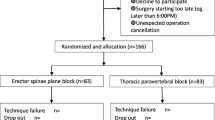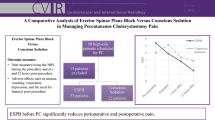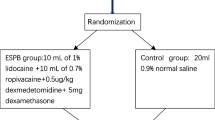Abstract
Background
The postoperative pain in percutaneous nephrolithotomy (PCNL) is due to dilatation of the renal capsule and the parenchymal tract. The aim of the study was to evaluate the analgesic effect of preoperative single-shot ultrasound(US)-guided erector spinae plane block (ESPB) at theT11 vertebral level in patients undergoing PCNL.
Material and methods
In this prospective randomized controlled study 56 patients were randomized into 2 groups; group B and group C. An erector spinae plane block (ESPB) was performed preoperatively in all patients; patients in group B received 30 ml 0.25% bupivacaine, while patients in group C received 30 ml normal saline as placebo. The following parameters were evaluated: intraoperative fentanyl consumption, time to first use of patient controlled analgesia (PCA), postoperative morphine consumption over 24 h, pain scores at 0, 2, 4, 6, 12 and 24 h, sedation scores at 2, 6, 12 and 24 h, and patient satisfaction.
Results
Patients in group B had lower intraoperative fentanyl consumption (P = 0.01), longer time to first use of PCA (P = 0.01), lower rescue morphine consumption over 24 h (P = 0.002), and higher patient satisfaction scores (P = 0.02). Postoperative numerical rating scale scores were lower in group B at 2 and 12 h (median = 3 and 2, respectively), as opposed to the control group (median = 4 and 3, respectively, P = 0.02). Sedation scores were higher in group C at 2 and 6 h after the procedure (P = 0.02 and 0.03, respectively).
Conclusion
The use of US-guided ESPB provides a good postoperative analgesia and decreases opioid consumption over 24 h in patients undergoing PCNL.
Zusammenfassung
Hintergrund
Der postoperative Schmerz nach perkutaner Nephrolithotomie (PCNL) ist bedingt durch eine Dilatation der Nierenkapsel und des Parenchymbereichs. In der vorliegenden Studie wurde der analgetische Effekt eines präoperativen Ultraschall(US)-gesteuerten M.-erector-spinae-Ebenen-Blocks (ESPB) in Einzelapplikation auf Höhe des Wirbels Th11 bei Patienten untersucht, die eine PCNL erhielten.
Material und Methoden
In dieser prospektiven, randomisierten, kontrollierten Studie wurden 56 Patienten in 2 Gruppen randomisiert: Gruppe B und Gruppe C. Ein ESPB wurde präoperativ bei allen Patienten durchgeführt; die Patienten in Gruppe B erhielten 30 ml 0,25% Bupivacain, die Patienten in Gruppe C 30 ml Kochsalzlösung als Plazebo. Folgende Parameter wurden bestimmt: intraoperativer Fentanylverbrauch, Zeit bis zur ersten PCA(Patienten-kontrollierte Analgesie)-Anwendung, postoperativer Morphinverbrauch in den ersten 24 h, Schmerzwerte nach 0, 2, 4, 6, 12 und 24 h, Sedierungswerte nach 2, 6, 12 und 24 h und Patientenzufriedenheit.
Ergebnisse
Bei den Patienten in Gruppe B war der intraoperative Fentanylverbrauch geringer (P = 0,01), die Dauer bis zur ersten PCA-Anwendung länger (P = 0,01), der bedarfsmäßige Morphinverbrauch über 24 h geringer (P = 0,002) und die Patientenzufriedenheit höher (P = 0,02). Die postoperativen Werte auf einer numerischen Rating-Skala waren in Gruppe B nach 2 und 12 h niedriger (Median = 3 bzw. 2) als in der Kontrollgruppe (Median = 4 bzw. 3, P = 0,02). Die Sedierungswerte waren in Gruppe C 2 und 6 h nach dem Eingriff höher (P = 0,02 bzw. 0,03).
Schlussfolgerung
Die Anwendung des US-gesteuerten ESPB bietet eine gute postoperative Analgesie und senkt den Opioidverbrauch über 24 h bei Patienten, die einer PCNL unterzogen werden.



Similar content being viewed by others
References
Antonelli JA, Pearle MS (2013) Advances in percutaneous nephrolithotomy. Urol Clin North Am 40:99–113
Parikh GP, Shah VR, Modi MP, Chauhan NC (2011) The analgesic efficacy of peritubal infiltration of 0.25 % bupivacaine in percutaneous nephrolithotomy, a prospective randomized study. J Anaesthesiol Clin Pharmacol 27:481–484
Dalela D, Goel A, Singh P, Shankhwar SN (2004) Renal capsular block: a novel method for performing percutaneous nephrolithotomy under local anesthesia. J Endourol 18:544–546
Forero M, Adhikary SD, Lopez H, Tsui C, Chin KJ (2016) The erector spinae plane block: a novel analgesic technique in thoracic neuropathic pain. Reg Anesth Pain Med 41:621–627
Muñoz F, Cubillos J, Bonilla AJ, Chin KJ (2017) Erector spinae plane block for postoperative analgesia in pediatric oncological thoracic surgery. Can J Anaesth. https://doi.org/10.1007/s12630-017-0894-0
Hamilton DL, Manickam B (2017) Erector spinae plane block for pain relief in rib fractures. Br J Anaesth 118:474–475. https://doi.org/10.1093/bja/aex013
Kinjo S, Schultz A (2019) Continuous lumbar erector spinae plane block for postoperative pain management in revision hip surgery: a report of two cases. Rev Bras Anestesiol. https://doi.org/10.1016/j.bjane.2019.02.002
Chin KJ, Adhikary S, Sarwani N, Forero M (2017) The analgesic efficacy of pre-operative bilateral erector spinae plane (ESP) blocks in patients having ventral hernia repair. Anaesthesia. https://doi.org/10.1111/anae.13814
Gurkan Y, Aksu C, Kuş A, Yorukoglu UH, Kilic CT (2018) Ultrasound-guided erector spinae plane block reduces postoperative opioid consumption following breast surgery: a randomized controlled study. J Clin Anesth 50:65–68
Tulgara S, Kapaklib MS, Senturka O, Selvia O, Serifsoya TE, Ozera Z (2018) Evaluation of ultrasound-guided erector spinae plane block for postoperative analgesia in laparoscopic cholecystectomy: a prospective, randomized, controlled clinical trial. J Clin Anesth 49:101–106
Ramsay MA, Savege TM, Simpson BR, Goodwin R (1974) Controlled sedation with alphaxalone-alphadolone. Br Med J 2:656–659
Muzrakchi AA, Szmigielski W, Omar AJ, Younes NM (2004) Is the 10th and 11th intercostal space a safe approach for percutaneous nephrostomy and nephrolithotomy? Cardiovasc Intervent Radiol 27:503–506
Chin KJ, McDonnell JG, Carvalho B, Sharkey A, Pawa A, Gadsden J (2017) Essentials of our current understanding: abdominal wall blocks. Reg Anesth Pain Med 42:133–183
Ak K, Gursoy C, Duger AC, Isbir K, Kaygusuz I, Ozdemir Kol G et al (2013) Thoracic paravertebral block for postoperative pain management in percutaneous nephrolithotomy patients: a randomized controlled clinical trial. Med Princ Pract 22:229–233
Li C, Song C, Wang W, Song C, Kong X (2016) Thoracic paravertebral block versus epidural anesthesia combined with moderate sedation for percutaneous nephrolithotomy. Med Princ Pract 25:417–422
Karmakar MK (2001) Thoracic paravertebral block. Anesthesiology 95:771–780
Forero M, Rajarathinam M, Adhikary S, Chin KJ (2017) Continuous erector spinae plane block for rescue analgesia in thoracotomy after epidural failure: a case report. A A Case Rep 8:254–256
Tulgar S, Senturk O (2018) Ultrasound guided erector spinae plane block at L‑4 transverse process level provides effective postoperative analgesia for total hip arthroplasty. J Clin Anesth 44:68
Chin KJ, Malhas L, Perlas A (2017) The erector spinae plane block provides visceral abdominal analgesia in bariatric surgery: a report of 3 cases. Reg Anesth Pain Med 42:372–376
Bonvinci D, Tagliapietra L, Giacomazzi A, Pizzirani E (2017) Bilateral ultrasound-guided erector spinae plane blocks in breast cancer and reconstruction surgery. J Clin Anesth 44:13–14
Aksu C, Gurkan Y (2018) Ultrasound-guided erector spinae block for postoperative analgesia in pediatric nephrectomy surgeries. J Clin Anesth 45:35–36
Adhikary SD, Bernard S, Lopez H, Chin KJ (2018) Erector spinae plane block versus retrolaminar block: a magnetic resonance imaging and anatomical study. Reg Anesth Pain Med 43(7:756–762
Ivanusic J, Konishi Y, Barrington MJ (2018) A cadaveric study investigating the mechanism of action of erector spinae blockade. Reg Anesth Pain Med 43(6):567–571
Kim E, Kwon W, Oh S, Bang S (2018) The erector spinae plane block for postoperative analgesia after percutaneous nephrolithotomy. Chin Med J 131(15):1877–1878
Singh S, Kumar G, Akhileshwar (2019) Ultrasound-guided erector spinae plane block for postoperative analgesia in modified radical mastectomy: a randomised control study. Indian J Anaesth 63:200–204
Author information
Authors and Affiliations
Corresponding author
Ethics declarations
Conflict of interest
M. Ibrahim and A. M. Elnabtity declare that they have no competing interests.
All procedures performed in studies involving human participants or on human tissue were in accordance with the ethical standards of the institutional and/or national research committee and with the 1975 Helsinki declaration and its later amendments or comparable ethical standards. Informed consent was obtained from all individual participants included in the study.
Rights and permissions
About this article
Cite this article
Ibrahim, M., Elnabtity, A.M. Analgesic efficacy of erector spinae plane block in percutaneous nephrolithotomy. Anaesthesist 68, 755–761 (2019). https://doi.org/10.1007/s00101-019-00673-w
Received:
Revised:
Accepted:
Published:
Issue Date:
DOI: https://doi.org/10.1007/s00101-019-00673-w




